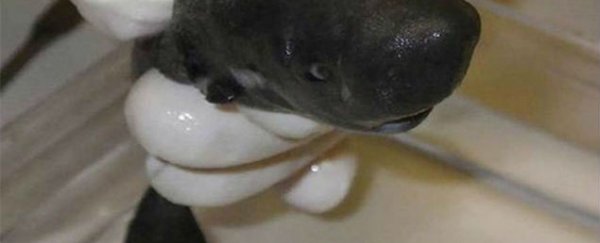Scientists working off the coast of the US have found something pretty incredible - the second pocket shark ever discovered, some 36 years after the first one was spotted off the coast of Peru.
The team, from the National Oceanic and Atmospheric Administration (NOAA), say the tiny creature - which measures just 13 cm (5.5 inches) long - was caught off the coast of Louisiana, where they were observing the feeding habits of sperm whales. It belongs to the genus Mollisquama, which has earned itself the nickname 'pocket shark', not because of its pocked-sized dimensions, but because of the unique and rather mysterious orifice it has above its pectoral fin.
"The pocket shark we found was only 5.5 inches long, and was a recently born male," lead researcher Mark Grace, said in a press release, noting that it displayed an unhealed umbilical scar. "Discovering him has us thinking about where mum and dad may be, and how they got to the Gulf. The only other known specimen was found very far away, off Peru, 36 years ago."
Unfortunately for this little baby shark, it was frozen along with a whole bunch of fish in 2010 as part of the team's investigation into sperm whale food. They've been sorting through the frozen morsels over the past five years, and have only just now discovered that alone pocket shark was among them. The distinctive pocket gland is what gave away its identity.
The team describes the specimen in the latest edition of Zootaxa, reporting that genetic analysis turned up the kitefin shark and the cookie cutter shark as its closest relatives. While they're not exactly sure what the odd little pocket orifice does, Molly Fosco reports at Discovery News that they suspect it could be for releasing pheromones, based on previous research of similar species.
"This record of such an unusual and extremely rare fish is exciting, but it's also an important reminder that we still have much to learn about the species that inhabit our oceans," Grace said.
We're just glad we now know that pocket sharks exist, because they're our new favourite animal.
Sources: NOAA, Discovery News
